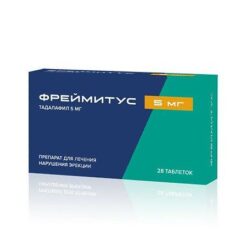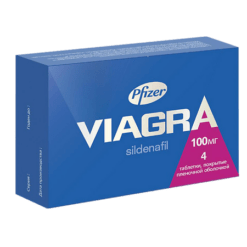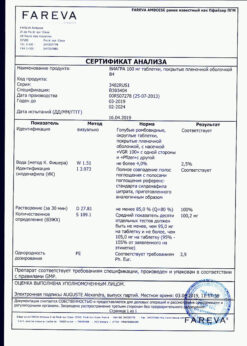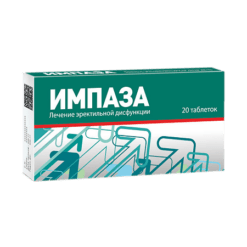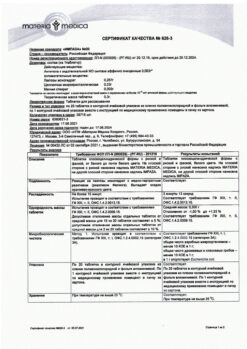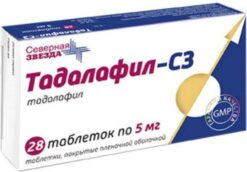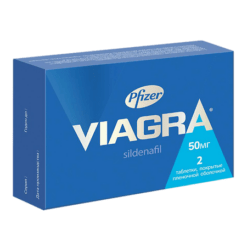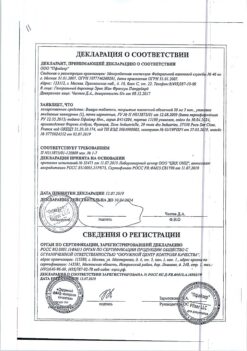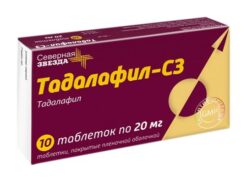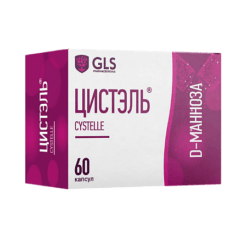No products in the cart.
Freimitus, 20 mg 8 pcs.
€1.00
Out of stock
(E-mail when Stock is available)
Description
Pharmacotherapeutic group:
Erectile dysfunction treatment – FDE 5 inhibitor
ATX code: G04BE08
Pharmacological properties
Pharmacodynamics
Tadalafil is a reversible selective type 5 specific phosphodiesterase (PDE-5) inhibitor of cyclic guanosine monophosphate (cGMP). When sexual arousal causes local release of nitric oxide, inhibition of FDE-5 by tadalafil leads to increased concentration of cGMP in the cavernous body of the penis. The consequence of this is relaxation of arterial smooth muscles and blood flow to the tissues of the penis, which causes an erection.
In vitro studies have shown that tadalafil is a selective inhibitor of FDE-5. FDE-5 is an enzyme present in the smooth muscle of the cavernous body, vessels and internal organs, in skeletal muscles, platelets, kidneys, lungs and cerebellum. The action of tadalafil on FDE-5 is more active than on other phosphodiesterases. Tadalafil is 10,000 times more potent against FDE-5 than other types of phosphodiesterases (FDE-1, FDE-2, FDE-4 and FDE-7), which are localized in the heart, brain, blood vessels, liver, leukocytes and other organs.
Tadalafil is 10,000 times more active in blocking FDE-5 than FDE-3, an enzyme found in the heart and blood vessels. This selectivity for FDE-5 over FDE-3 is important because FDE-3 is an enzyme involved in heart muscle contraction. In addition, tadalafil is about 700 times more active against FDE-5 than against FDE-6, which is found in the retina and is responsible for phototransmission. Tadalafil is 9,000 times more potent against FDE-5 than it is against FDE-8, FDE-9, and FDE-10, and 14 times more potent than it is against FDE-11. The tissue distribution and physiological effects of FDE-8 to FDE-11 inhibition have not yet been elucidated.
Tadalafil in healthy volunteers causes no significant change in systolic and diastolic blood pressure compared to placebo in the supine position (mean maximum reduction is 1.6 and 0.8 mm Hg, respectively). Tadalafil does not cause a significant change in heart rate when standing (mean maximum reduction is 0.2 and 4.6 mmHg, respectively).
Tadalafil does not cause changes in color recognition (blue/green), which is due to its low affinity for FDE-6. In addition, there is no effect of tadalafil on visual acuity, electroretinogram, intraocular pressure and pupil size.
To evaluate the effect of daily tadalafil administration on spermatogenesis, several studies have been conducted. No adverse effect on sperm morphology and motility was observed in any of the studies. One study found a decrease in average sperm concentration compared to placebo. The decrease in sperm concentration was associated with a higher frequency of ejaculation. In addition, when comparing tadalafil with placebo there was no undesirable effect on the average concentration of sex hormones (testosterone, luteinizing hormone and follicle stimulating hormone).
Erectile Dysfunction (ED)
Tadalafil has shown statistically significant improvement in erectile function and the ability to have a full sexual intercourse in studies. Tadalafil has no effect in the absence of sexual arousal.
The effectiveness and safety of tadalafil have been studied in clinical trials. Improvement of erections in patients with ED of all degrees of severity was noted when tadalafil 5 mg was taken once daily for 36 hours after intake, and maintenance of erections within 16 minutes after intake was compared to placebo. In studies of primary efficacy of tadalafil 5 mg, 57% and 67% of sexual attempts were successful, compared with 31% and 37% when taking placebo. In studies of patients with secondary ED on diabetes, 41% of sexual attempts were successful compared to 28% on placebo.
Benign prostatic hyperplasia (BPH)
. In patients with BPH, tadalafil, by inhibiting FDE-5, leads to increase of cGMP concentration not only in cavernous body of penis but also in smooth muscle of prostate, bladder and vessels which supply blood to them. It in its turn increases blood perfusion in these organs and, as a consequence, reduces severity of BPH symptoms. Relaxation of the smooth muscles of the prostate and bladder and inhibition of afferent innervation of the bladder may additionally enhance vascular effects.
In clinical studies, a reduction in symptoms of BPH within 1 week of taking 5 mg of tadalafil compared to placebo has been shown.
In studies including patients with ED and symptoms of BPH, 71.9% of sexual attempts were successful with tadalafil 5 mg compared to 48.3% with placebo, and there was a significant improvement in erectile function and reduction in prostate symptoms.
Pharmacokinetics
Intake
Tadalafil is rapidly absorbed after oral administration. Mean maximum concentration (Cmax) in blood plasma is reached on average in 2 hours after oral administration.
The speed and degree of absorption of tadalafil are not dependent on food intake, so the drug can be used regardless of meals. The time of administration (morning or evening) has no clinically significant effect on the rate and extent of absorption.
The pharmacokinetics of tadalafil in healthy volunteers are linear with respect to time and dose. In the dose range of 2.5 to 20 mg, the area under the concentration-time curve (AUC) increases in proportion to the dose. Equilibrium plasma concentrations are reached within 5 days if the drug is taken once daily. Pharmacokinetics of tadalafil in patients with erectile dysfunction is similar to the pharmacokinetics of the drug in patients without erectile dysfunction.
Distribution
The average volume of distribution is about 63 liters, indicating that tadalafil is distributed in body tissues.
In therapeutic concentrations, 94% of tadalafil binds to plasma proteins. Binding to plasma proteins is not altered in impaired renal function.
In healthy volunteers, less than 0.0005% of the administered dose is found in semen.
Metabolism
Tadalafil is mainly metabolized with participation of cytochrome P450 isoenzyme CYP3A4. The main circulating metabolite is methylcatecholglucuronide. This metabolite is at least 13,000 times less active against FDE-5 than tadalafil. Consequently, the concentration of this metabolite is not clinically significant.
Elimation
In healthy volunteers, the average clearance of tadalafil when taken orally is 2.5 L/h and the average half-life (T1/2) is 17.5 h. Tadalafil is excreted primarily as inactive metabolites, mainly by the intestine (about 61% of the dose) and, to a lesser extent, by the kidneys (about 36% of the dose).
Elderly patients
Healthy elderly volunteers (65 years and older) had lower clearance of tadalafil when ingested, as reflected by a 25% increase in AUC compared to healthy volunteers aged 19 to 45 years. This difference is not clinically significant and does not require dose adjustment.
Patients with renal impairment
. In clinical studies, a single dose of tadalafil (5-20 mg) has been shown to increase AUC by approximately 2-fold in patients with mild (creatinine clearance (CK) 51-80 ml/min), moderate (CK 31-50 ml/min) and terminal renal impairment (performing dialysis). In patients on hemodialysis, the Cmax of tadalafil is 41% higher than in healthy volunteers. Tadalafil is practically not excreted in hemodialysis.
Patients with hepatic impairment
The pharmacokinetics of tadalafil in patients with mild to moderate hepatic impairment (Child-Pugh grades A and B) are comparable to those of healthy volunteers. For patients with severe hepatic impairment (Child-Pugh class C), data are limited, so a benefit/risk assessment should be performed before using the drug.
Patients with diabetes mellitus
Patients with diabetes mellitus on tadalafil have an AUC approximately 19% lower than that of healthy volunteers. This difference does not require a dose adjustment.
Indications
Indications
Active ingredient
Active ingredient
How to take, the dosage
How to take, the dosage
Interaction
Interaction
Special Instructions
Special Instructions
Diagnosis of ED and BPH should include identification of the underlying cause, appropriate physical examination, determination of treatment strategy, and individualized benefit/risk assessment. Sexual activity has potential risks for patients with cardiovascular disease, so treatment for ED should not be undertaken in men with heart conditions for which sexual activity is not recommended.
Like other FDE-5 inhibitors, tadalafil may have a systemic vasodilator effect, which may lead to a transient decrease in BP and increase the hypotensive effect of nitrates, alpha-adrenoblockers (see section “Interaction with other medicinal products”). Before prescribing the drug, the possibility of such adverse reactions in patients with cardiovascular disease should be carefully evaluated.
Patients with a suspected diagnosis of BPH should be evaluated to rule out prostate cancer.
Non-arterial anterior ischemic optical neuropathy (NAPION) causes visual impairment, including total vision loss. There have been rare post-marketing reports of cases of NAPION, time-consistently associated with the administration of FDE-5 inhibitors. At this time, it is not possible to determine whether there is a direct association between the development of NAPION and the intake of FDE-5 inhibitors or other factors. Patients should be cautioned that in the event of sudden vision loss, tadalafil should be discontinued and medical attention should be sought. Patients should also be informed that people who have had NAPION are at increased risk of developing NAPION again.
The occurrence of priapism has been reported with the use of FDE-5 inhibitors, including tadalafil. Patients should be informed to seek immediate medical attention if an erection lasts 4 hours or more. Failure to treat priapism in a timely manner leads to damage to penile tissue, which may result in permanent impotence.
The efficacy of the drug in patients who have undergone pelvic surgery or radical nerve-sparing prostatectomy is unknown.
While the incidence of dizziness on placebo and tadalafil is the same, during treatment, caution should be exercised when driving vehicles and engaging in other potentially dangerous activities requiring increased concentration and rapid psychomotor reactions.
Patients should be aware of the possible development of somnolence when taking the drug, especially at the beginning of therapy or in combination with alcohol intake.
Contraindications
Contraindications
Side effects
Side effects
Overdose
Overdose
Pregnancy use
Pregnancy use
Similarities
Similarities
Additional information
| Shelf life | 3 years. Do not use after the expiration date. |
|---|---|
| Conditions of storage | At a temperature not exceeding 25 ° C. Keep out of reach of children. |
| Manufacturer | Ozon, Russia |
| Medication form | pills |
| Brand | Ozon |
Other forms…
Related products
Buy Freimitus, 20 mg 8 pcs. with delivery to USA, UK, Europe and over 120 other countries.


